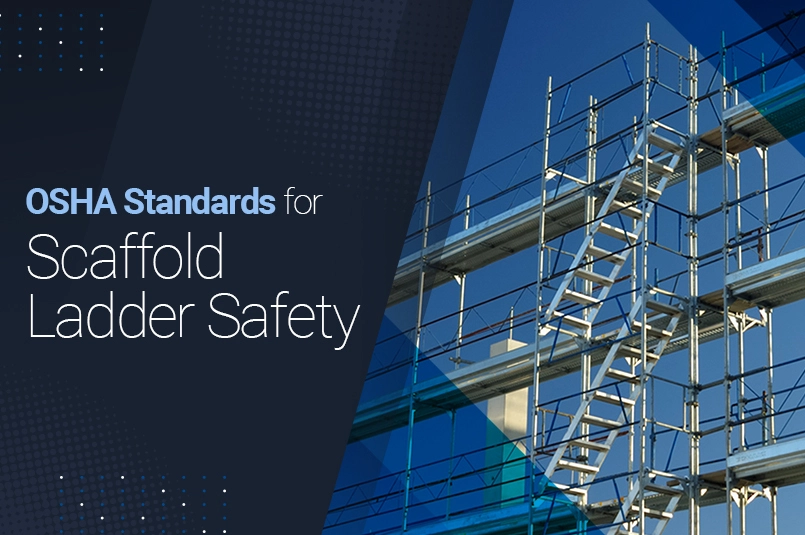
Scaffolding is a temporary structure used in construction, maintenance, and repair work to provide access to elevated areas. Scaffold ladders are an integral part of scaffolding, providing a means for workers to safely climb up and down from elevated work areas.
However, accidents involving scaffold ladders can lead to serious injuries or even fatalities. In order to ensure the safety of workers, the Occupational Safety and Health Administration (OSHA) has established specific standards for scaffold ladder safety.
In this blog, we will discuss the OSHA standards for scaffold ladder safety and provide tips on how to implement them to create a safe working environment for your employees.
OSHA Rules To Be Followed While Using Any Type Of Scaffold Ladders
The Occupational Safety and Health Administration (OSHA) has established specific rules and regulations that must be followed when using any type of ladder scaffolding. Here are some of the key OSHA rules that must be followed:
- Scaffold ladders must be designed to support at least four times their maximum intended load, and they must be constructed of materials that are able to withstand the load without failure. Steel ladder brackets are a popular choice for securing scaffold ladders due to their strength and durability. They are designed to withstand the weight of the ladder and the weight of the worker, providing a safe and secure means of access to elevated work areas.
- Ladder scaffolding must be inspected before each use to ensure that they are in good condition and free from defects. Any ladders that show signs of damage or wear must be taken out of service and repaired or replaced.
- Scaffold ladders must be placed on a stable and level surface, and they must be secured to prevent them from shifting or falling.
- Scaffold ladders must be secured to the scaffold or structure, and they must be positioned so that workers can easily access the work area.
- Workers must be trained in the safe use of scaffold ladders, and they must use them in a safe and appropriate manner. Use of ladder brackets for scaffolding must be done to ensure safe working. Workers must also face the ladder when ascending or descending, and they must not carry any tools or materials in their hands while on the ladder.
- Employees who are working on scaffold ladders must be protected from falls. This can be achieved through the use of personal fall arrest systems or guardrails.
- Scaffold ladders must be maintained in good condition and must be repaired or replaced if they become damaged or worn. Any modifications to the ladder brackets must be made by a qualified person and must comply with OSHA regulations.
- Ladders should not be used on slippery areas if they are not fastened or fitted with feet that are slip-resistant to prevent accidental sliding. According to OSHA standards for ladder safety, ladder brackets must be used to secure scaffold ladders in place and prevent them from slipping or falling.
- While ladder scaffoldings are in use, you should never attempt to move, relocate, or raise them.
- On a ladder, you should avoid carrying items or other things that might cause you to lose your balance and fall down the ladder.
It is important to note that these rules are not exhaustive, and additional regulations may apply depending on the specific work site and the type of scaffold ladder being used. Employers should consult OSHA regulations and guidelines for a complete understanding of the rules that apply to their specific situation.
Various Types of Scaffold Ladders
There are several types of scaffold ladders that are commonly used in construction and maintenance work, including:
- Single-section ladder: A single-section ladder is a straight ladder that does not have any movable parts. It is typically used for low to medium-height tasks.
- Extension ladder: An extension ladder consists of two or more sections that can be extended or retracted as needed. It is used for tasks that require workers to reach greater heights.
- Rolling ladder: A rolling ladder is a type of ladder that has wheels attached to the bottom. It can be easily moved from one location to another, making it a popular choice for tasks that require workers to move around frequently.
- Step ladder: A step ladder is a self-supporting ladder that is designed to be used on flat surfaces. It is commonly used for tasks that require workers to access equipment or materials at a low to medium height.
- Suspended scaffold: A suspended scaffold ladder is a type of ladder that is suspended from a structure using ropes or cables. It is used for tasks that require workers to access elevated work areas that cannot be reached with traditional ladders.
Ensuring Scaffold Ladder Safety With OSHA Standards
Ensuring the safety of workers on scaffolding is of utmost importance in all the industries. Scaffold ladders are provided by scaffolds supply and are an essential component of scaffolding, providing access to elevated work areas.
However, accidents involving scaffold ladders can result in serious injuries or even fatalities. That’s why the Occupational Safety and Health Administration (OSHA) has established specific standards for scaffold ladder safety, aimed at reducing the risk of accidents and injuries.
By following these standards, employers can create a safe working environment for their employees and prevent accidents from occurring. It is crucial that employers provide adequate training to workers on ladder safety, properly maintain ladder equipment, and follow OSHA regulations to ensure the safety of all workers.
By taking these precautions, employers can protect their workers and minimize the risk of accidents and injuries on the job.











Comments are closed